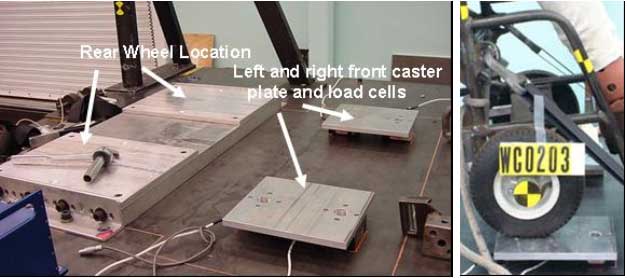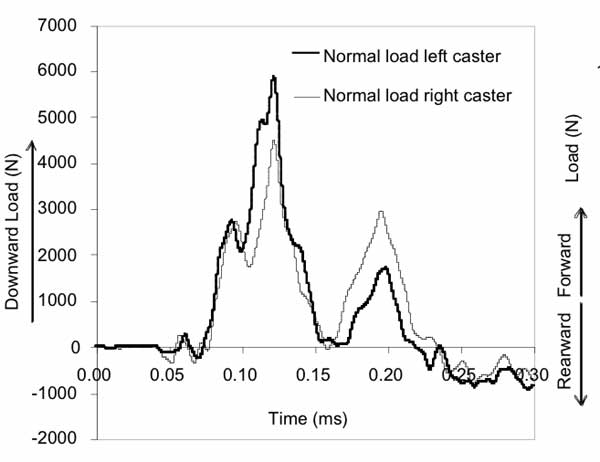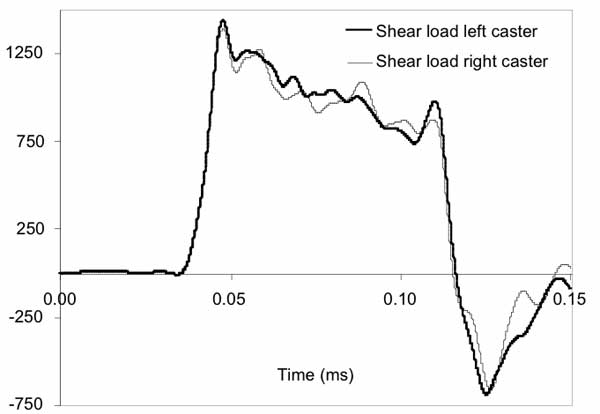ABSTRACT
Wheelchairs used as motor vehicle seats in para-transit or private vehicles are exposed to high level crash loading when engaged in motor vehicle crashes. Many wheelchairs are not typically designed to withstand the types of loading that may occur during impact. This study measured the normal and shear loading of front wheelchair wheels (casters) during a 48kph/20g frontal impact. Eight tests were run with a surrogate wheelchair base and a variety of wheelchair seat and back systems. The surrogate wheelchair base (SWCB) was secured with rear wheelchair securement anchors at three different heights (low, middle, high). Load cells were built into the sled test platform under the front casters. A test dummy representing a 50th percentile male occupant was seated in the SWCB.
Average normal caster loading resulting from frontal impact was 4738N (SD= 1709N). Average shear caster loading from frontal impact was 1343N (SD=224N). Highest normal caster loading corresponded with low rear securement point height scenarios and seat failure, as well as with high rear securement point height scenarios and seat and back failure due to dummy loading. Results from this study can be used to aid manufacturers in the design of crashworthy wheelchair casters.
BACKGROUND
Individuals who rely on wheelchairs for their daily mobility needs often use their wheelchair as a motor vehicle seat during transit. The majority of wheeled mobility devices have not been designed with the safety features that are implemented in motor vehicle seats [1-3]. The ANSI/RESNA WC19 standard for `Wheelchairs Used as Seats in Motor Vehicles' requires transport-option wheelchairs to be subjected to a 48kph/20g frontal impact testing [4]. Previous studies done on wheelchair components such as wheelchair seats, backs and attachment hardware show less than adequate performance of wheelchair components under crash loads [5-9]. Wheelchair casters and fork assemblies are designed to carry the weight of wheelchairs and to provide the wheelchair occupant with a comfortable ride during daily wheelchair use. When a wheelchair is being used as a motor vehicle seat, the casters function as a load bearing component during frontal impact. Frontal impact will cause caster loading due to forward and downward loading of the occupant onto the wheelchair seating system. Studies using computer simulations have also shown that factors such as rear wheelchair securement location, seat stiffness and seat angle can influence load patterns on wheelchair components in particular [3, 10] and may also influence caster loading [11]. Uncontrolled failure of the caster and/or caster fork may result in increased risk of occupant injury due to excessive forward occupant motion, as well as downward motion resulting in submarining (sliding of the pelvic belt onto the soft abdominal). Controlled caster assembly deformation (e.g energy absorbing characteristics integrated in caster assemblies) may reduce occupant risk of injury during frontal impact.
OBJECTIVES
The purpose of this study was to determine wheelchair caster loading during frontal impact testing. Additionally, the effect of rear securement point location and wheelchair seat system performance on caster loading was evaluated.
METHOD
To assess wheelchair caster loading, eight frontal sled impact tests were run with a 48kph/20g crash pulse using a surrogate wheelchair base (SWB) and a 50th percentile Hybrid III ATD. The SWB is a rigid wheelchair base (representing a commercial power wheelchair) intended for repeated sled impact testing to evaluate wheelchair seating systems. The SWB was secured using a four point tiedown system. The rear tiedown anchor heights were varied in height to evaluate their effect on caster loading. Various types of seating systems were mounted to the SWB to evaluate seating system crashworthiness and design on caster loading magnitude (table 1). To record the caster loads during frontal impact, two tri-axial load cells per caster wheel were positioned on the sled platform under the front caster wheels (figure 1).
 |
Peak normal caster loads (7209N) were seen in test scenarios with a combination of high rear wheelchair securement and seat system failure. Low rear wheelchair securement scenarios also showed high caster loads (5405, 5514 and 5824N). Wheelchair securement below the wheelchair center of gravity causes forward rotation of the wheelchair, thereby increasing caster loading. For all tests except one, peak normal loading occurred in the left of the two casters. This can be explained by the fact that the shoulder belt anchor point was located at the left of the ATD, causing rotation of the ATD to the left side of the wheelchair. Peak shear loading (1500, 1510 and 1589N) occurred throughout the various securement scenarios (low, middle and high), but was the highest in the right caster for the scenario with a low wheelchair securement point and seat failure (1589N). Figure 2 shows the characteristic caster loading patterns during frontal impact.
CONCLUSION
Peak caster loads (7209 N) were seen in impact scenarios where the wheelchair was secured high above the floor (457mm) and where the seat and back failed during the test. In the case where no seat failure occurred, low rear securement points lead to the highest caster loading. This preliminary study shows that seating system integrity and rear securement position can affect caster loading. Caster load magnitudes and patterns obtained from this study may guide manufacturers of caster assemblies in the design of crashworthy products. Our future research includes the development of an instrument that dynamically tests the crashworthiness of caster wheels and caster forks using the impact load information reported in this study.
 |
 |
REFERENCES
- Benson, B., et al., Effect of seat stiffness in out-of-position occupant response in rear end collisions. SAE, 1996.
-
Viano, D., Influence of seat back angle on occupant dynamics in simulated rear-end impacts. Society of Automotive Engineers (SAE), 1992.
-
Bertocci, G., et al., Development of Frontal Impact Crashworthy Wheelchair Seating Design Criteria Using Computer Simulation. Journal of Rehab Research and Development (JRRD), 2000. 37(5): p. 565-572.
-
ANSI/RESNA, ANSI/RESNA WC-19: Wheelchairs Used as Seats in Motor Vehicles. 2000, American National Standards Institute (ANSI)/Rehabilitation Engineering Society of North America (RESNA).
- Ha, D., et al., Evaluation of wheelchair back support crashworthiness: combination wheelchair back support surfaces and attachment hardware. Journal of Rehabilitation Research & Development, 2000. 37(5).
- Ha, D., et al., Evaluation of Wheelchair Seating System Crashworthiness: Combination Wheelchair Seat Back Surfaces and Attachment Hardware. J. of Rehab. Research and Development, 2000. 37 (5)(Sept/Oct): p. 555-563.
- Bertocci, G., et al., Evaluation of Wheelchair Drop Seat Crashworthiness. Medical Engineering & Physics, Vol. 23 (4), May 2001.
- Bertocci, G., et al., Evaluation of Wheelchair Seating System Crashworthiness: Drop Hook Type Seat Attachment Hardware. Archive of Physical Medicine and Rehabilitation, Vol 82 (4), April, 2001.
-
Ha, D., et al., Evaluation of wheelchair sling seat and sling back crashworthiness. Med.Eng&Ph, 2002. 24:p.441-448.
-
Bertocci, G.E., K. Digges, and D. Hobson, Development of transportable wheelchair design criteria using computer crash simulation. IEEE Transactions of Rehabilitation Engineering, 1996. 4(3): p. 171-181.
- Bertocci, G.E., et al., Testing and evaluation of wheelchair caster assemblies subjected to dynamic crash loading. Journal of Rehab Research and Development, 1999. 36(1): p. 32-41.
ACKNOWLEDGEMENTS
This research was conducted with support from the National Institute on Disability and Rehabilitation Research, Rehabilitation Engineering Research Center (RERC) on Wheeled Mobility, grant # H133E30005 and the RERC on Wheelchair Transportation, grant # H133E010302. We also thank the University of Michigan Transportation Research Institute for their assistance with testing and instrumentation. Opinions expressed are the authors' and do not necessarily represent the opinions of NIDRR.
Linda
van Roosmalen, PhD
University of Pittsburgh
Dept of Rehabilitation Science and Technology
5044 Forbes Tower
Pittsburgh, PA 15260
email: Lvanroos@pitt.edu
